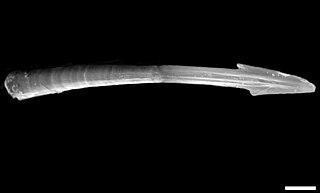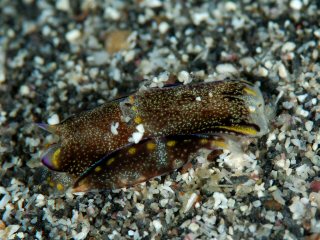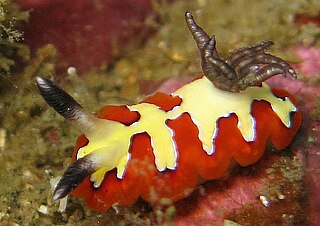
The clade Cephalaspidea, also known as the headshield slugs and bubble snails, is a major taxon of sea slugs and bubble snails, marine gastropod mollusks within the larger clade Euopisthobranchia. Bubble shells is another common name for these families of marine gastropods, some of which have thin bubble-like shells. This clade contains more than 600 species.

A love dart is a sharp, calcareous or chitinous dart which some hermaphroditic land snails and slugs create. Love darts are both formed and stored internally in a dart sac. These darts are made in sexually mature animals only, and are used as part of the sequence of events during courtship, before actual mating takes place. Darts are quite large compared to the size of the animal: in the case of the semi-slug genus Parmarion, the length of a dart can be up to one fifth that of the semi-slug's foot.

Goniobranchus coi is a species of very colourful sea slug, a dorid nudibranch, a marine gastropod mollusc in the family Chromodorididae.

Goniobranchus preciosus is a species of colourful sea slug, a dorid nudibranch, a marine gastropod mollusc in the family Chromodorididae.

Nembrotha cristata is a species of colourful sea slug, a polycerid nudibranch, a marine gastropod mollusk in the family Polyceridae. This species of sea slug is black with green markings; adults are around 50 mm in length, and they live on rock or coral reefs in the tropical Indo-West Pacific Ocean.

Chromodoris joshi is a species of sea slug. It is a dorid nudibranch, a shell-less marine gastropod mollusc in the family Chromodorididae.

Philiopsis is a genus of often colorful, medium-sized sea slugs, marine opisthobranch gastropod mollusks. These are not nudibranchs; instead they are headshield slugs, in the clade Cephalaspidea.

Chromodoris aspersa is a species of colourful sea slug, a dorid nudibranch, a marine gastropod mollusc in the family Chromodorididae.
Goniobranchus kitae is a species of colourful sea slug, a dorid nudibranch, a marine gastropod mollusc in the family Chromodorididae.
Goniobranchus galactos is a species of colourful sea slug, a dorid nudibranch, a marine gastropod mollusc in the family Chromodorididae.

Goniobranchus gleniei is a species of colourful sea slug, a dorid nudibranch, a marine gastropod mollusc in the family Chromodorididae.

Goniobranchus fidelis, also commonly known as the faithful sea slug, is a species of colourful sea slug, a dorid nudibranch, a marine gastropod mollusc in the family Chromodorididae.

Goniobranchus roboi, common name the tooth-edged chromodoris, is a species of colourful sea slug, a dorid nudibranch, a marine gastropod mollusc in the family Chromodorididae. This species was transferred from Chromodoris to Goniobranchus in 2012.

Goniobranchus vibratus, common name trembling nudibranch, is a species of colourful sea slug, a dorid nudibranch, a marine gastropod mollusc in the family Chromodorididae.

Goniobranchus tumuliferus is a species of colourful sea slug, a dorid nudibranch, a marine gastropod mollusc in the family Chromodorididae.

Goniobranchus sinensis is a species of colourful sea slug, a dorid nudibranch, a marine gastropod mollusc in the family Chromodorididae.
Goniobranchus cazae is a species of colourful sea slug, a dorid nudibranch, a marine gastropod mollusc in the family Chromodorididae.

Goniobranchus reticulatus is a species of colourful sea slug or dorid nudibranch, a marine gastropod mollusk in the family Chromodorididae.

Siphopteron quadrispinosum is a species of small sea slug, a marine opisthobranch gastropod mollusc in the order Cephalaspidea, the headshield slugs. This slug is a simultaneous hermaphrodite.

Gastropteron is a genus of small colorful sea slugs, marine gastropod molluscs in the family Gastropteridae.

















